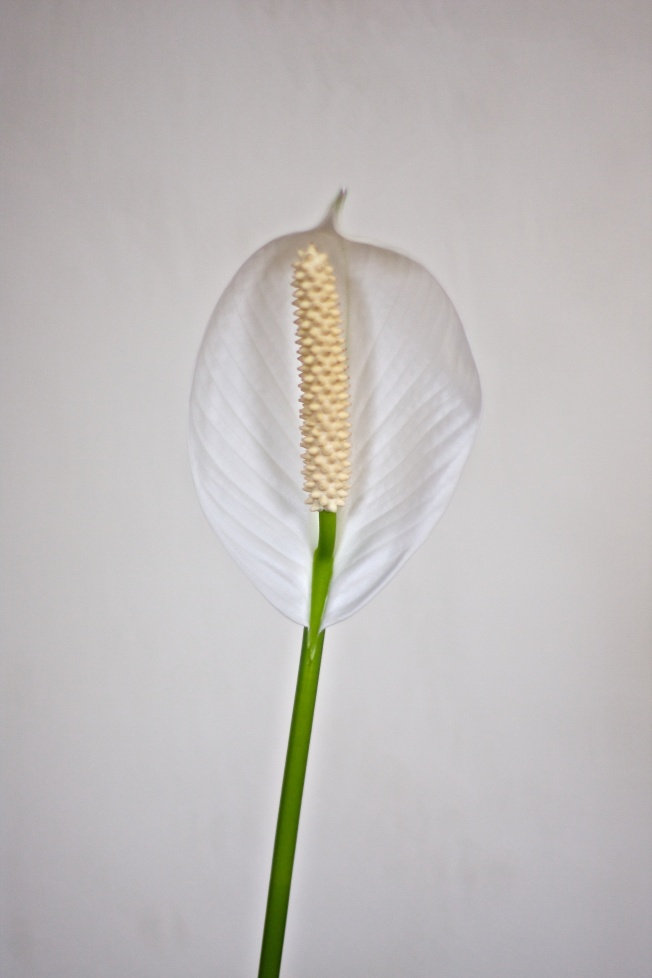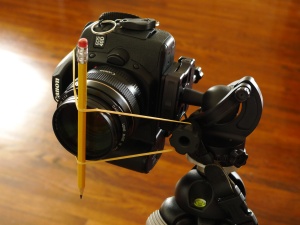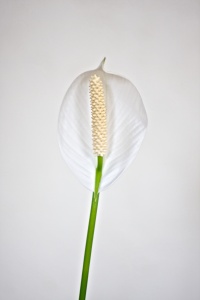Okay, take a look at the photo above. Notice anything strange about it? Probably not, but in fact there’s something quite different about it, or at least about the camera setup used to take the photo. Here, let me show you:
Yes, that’s right, the camera has a pencil rubberbanded right across the middle of the lens. Look back at the original photo… no pencil! So what gives?
This subject came up on the This Week in Photography podcast a few weeks ago where someone asked why the scratches on the front of his lens weren’t showing up in his photos. And the reason has to do with the fact that shooting with a large aperture will do an amazing job of hiding dirt or scratches on the front of a lens (or on a filter in front of the lens).
Without getting too deep into the optics behind this phenomenon, it primarily has to do with the fact that a wide open aperture means that you’re gathering light from the entire surface of the lens and focusing it on each element in your sensor. When you ‘stop down’, i.e. set the lens to a smaller aperture, every pixel in your photo is based on light from a much smaller area of the lens. The net result is that with a lens set to a large aperture, about all you’ll notice when you’ve got something blocking a portion of the lens is a decrease in the brightness of the image. Here’s the original image side-by-side with a shot taken without the pencil, using exactly the same f-stop, shutter speed, iso and lighting conditions. The image on the right is brighter, due to fact that light isn’t being blocked by a pencil…
So how is this information useful to the average photographer? Well, I can think of at least two times I’ve used it to my benefit. The first was when I wanted to get a photo of something that was behind a chain-link fence. Shooting at some small aperture like f16 would put an ugly bit of the fence across part of my image but dropping down to a wide aperture would make the fence disappear.
Another more common example is when shooting in conditions where water drops can end up on the lens – either if it’s raining or if you’re standing next to a waterfall, perhaps. Shooting at a wider aperture gives the photographer the ability to ignore a little bit of spray without fear of ruined photos.
Here’s a little animated gif where I shot a sequence of frames, decreasing the aperture each time. The range is from f1.4 down to f22.
Now, to be fair, there are subtle degradations that can happen to the image, including a loss of sharpness and various diffraction artifacts. But it’s a nice trick to have in your repertoire of techniques.
Anybody else have good examples of using a wide aperture to make something invisible?
UPDATE: A couple of good notes from the comments. My buddy Joseph Linaschke notes that this trick is also useful if you’ve got a bit of dirt on the actual image sensor of your camera, and Hugh makes the great point that this is effectively changing the shape of the aperture, which means you can use it to modify the characteristics of the bokeh in the out-of-focus areas. Thanks guys!






Extremely interesting (and useful)! Thanks for the info Ron.
Hi Ron. A great tutorial. I use this technique to “shoot through” chain link fences at motorcycle races (and other events). Place the camera close to the fence and shoot wide open and the fence “disappears”. There is a definite loss of contrast in the image — especially if the fence is reflecting sunlight — but post-processing can clean that up quite a bit.
See http://dmg-photography.com/blog/2009/04/lrrs-racing for a discussion and examples.
Take care. Thanks for your TWIP contributions!
This is a great lesson for us all! I think this would be an extremely useful animation without the pencil as well, because it shows the effects of depth of field. It starts out with the background nicely blurred, almost like you shot against a white paper background or something, and at the end, it is clear you just used a white wall. Very excellent! Thank you!
Same thing goes for a dirty sensor. Shoot a white wall with the aperture closed all the way down and see your true dirt!
Very interesting indeed!
What a great demonstration. Excellent work Ron… I can imagine you wearing your white lab coat while running these tests! ;)
Excellent visual demonstration Dr. Ron! Useful information put in a way that most of us can see clearly (no pun intended…) Keep up the good work!
As well as using this to get rid of unwanted extremely-near foreground images, I do also like what it does to bokeh (well, anything defocused…)
Look at the tip of the petal in the first image – it’s a double-image, rather than just a blurred image. This is because the pencil is changing the shape of the aperture.
While a normal shot of the flower would have a circular aperture, with the pencil in front, it’s effectively a circle with a gap down the middle. If you took a shot like this at night, with small out of focus lights in the distance, you’d see a gap down the middle of each of them (where the gap is would actually change depending on where in the image the light is)
You can get lovely effects with this kind of thing. Any pattern or shape held right up to the lens will be reflected in the bokeh.
In fact, a quick search on Google Images for “bokeh” came up with these links:
Example image
How it was done
(I am in no way connected to each of the links above – they came purely through a Google search)
I usually shoot wide open and forgot how dramatic the differences in apeture size can be. Thanks for the reminder!
Thanks for the easy-to-understand explanation. :)
This technique also works really well when photographing out of filthy airplane windows!
+1 for shooting through fences :-D
Great Illustration.
Pingback: Lens Scratches…Open the Aperture. Problem Solved. | Camera Genesis
I had this happen quite by accident at the Memphis Zoo. There’s a chain link fence between me at the Jaguar in this shot.
I found this extremely interesting. Thank you!
Sylvia
Thanks for the article – very helpful reminder when facing obstacles out in the field.
I shot this Bald Eagle photo through a very pesky close knit mesh wire cage. http://www.flickr.com/photos/jkissnhug/4398060277/
This set of doors was shot through a chain link fence. Some fence shadow is visible, but considering the limits of the fence, I will take the shot. http://www.flickr.com/photos/jkissnhug/3459758668/in/set-72157616931589077/
Pingback: Falling Dominos No. 2 » Too Much Glass
Thankyou for a useful reminder!
I suspect you might find this interesting:
https://www.lensrentals.com/news/2008.10.30/front-element-scratches
Also worth looking around at their lens articles in general, some of them are highly informative.
Pingback: Yosemite Falls Moonbow » JMG-Galleries – Jim M. Goldstein Photography
Pingback: What Lens Should I Buy Next, & Other FAQs About Camera Gear